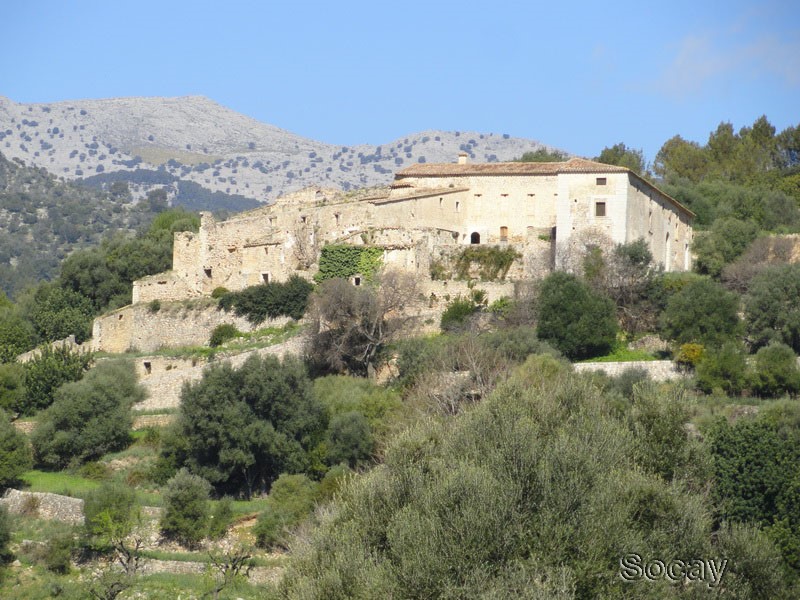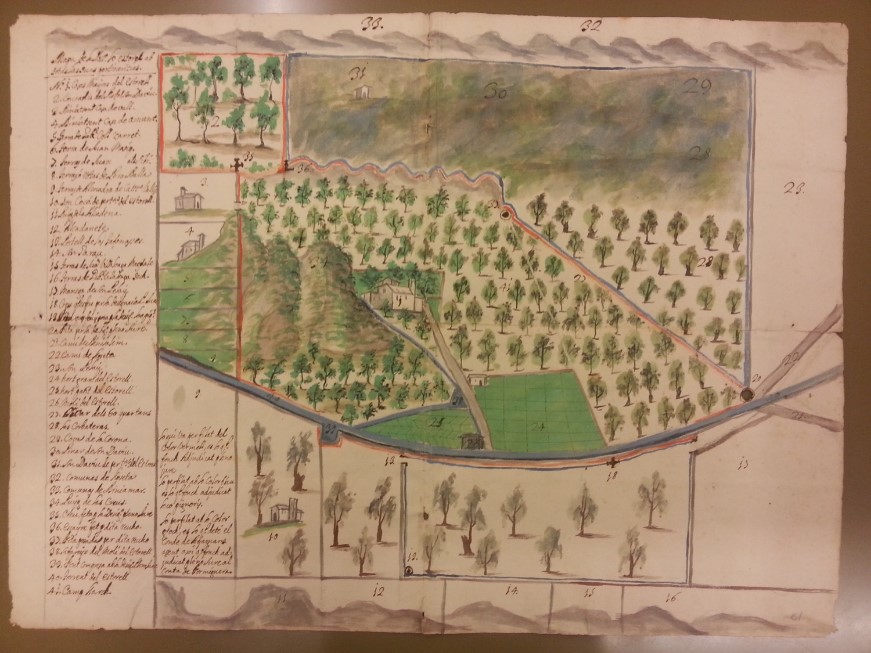GABRIEL JOVER-AVELLÀ & JOANA MARIA PUJADAS-MORA
An old olive-picker woman in 1980’s was interviewed on her working experience. She stated that ‘I started to go up to mountains, to pick olives, many times ago. It was about 1950. I lived in Maria de la Salut [a hamlet near Santa Margalida, Mallorca], I was 16 years old. I was the lasted of the eight sisters, and all of us worked harder to help our parents tilling our land plot’ (Llabrés & Vallespir, 1983: 169). In fact, this woman tells us about the end of a long history that comes from medieval times. In the island of Majorca, like in other Mediterranean islands and regions, the olive-trees were a backbone of agriculture and landscape of the Mediterranean Mountains. However, the island of Majorca had certain singularities as in the mid-seventeenth century it had become one of the major olive-oil export enclaves in the Mediterranean world. Close to 60% of the island production was exported, and the value of olive oil represented 70% of total exports from the island to the Atlantic urban markets.
Moreover, since the sixteenth century the distribution of land property was sharply unequal. On the one hand, there were great estates owned by aristocracy. On the other hand, surrounding the villages there were numerous small tenancies with not enough land to allow the reproduction of the family suppling labour to those great estates. The aristocratic farms in the plains were dedicated to cereal crops, and the mountains’ farms were devoted to olive groves. The landowners hired wage labour to cultivate farms: permanent labourers accounted for 35% of total days worked, and daily wage workers for 65%. Almost 70-80% of these daily-wage workers were women.

Olive-grove estates demanded female olive-pickers in harvest season, from October to February; but the local labour supply was not enough to cope with the demand of olive grove farms. In this way, cereal farming showed a more regular demand for women’s labour, hiring women from November to February for hoeing, and from March to May for weeding. However, poor households managed the demands of two labour markets, with a seasonal peak between October and February, when olive harvesting and cereal hoeing overlapped.
The aim of this post is to shed light on how female participation in two labour markets influenced their socio-demographic behaviour, i. e. family formation, as a dimension of agency in early modern Majorca (Spain). To meet this goal, we have reconstructed the life course and labour trajectories of the female olive pickers hired in Safortesa estate during the seventeenth century, linking their information from harvest logbooks and parish books using the Jaro-Winkler string distance. The harvest logbooks are exceptional sources recording the names of all the workers hired to pick olives and make olive oil for each olive harvest season, whether they were related by family and place of origin, the number of days worked, and the wages received (in cash and in kind).

In other studies, we showed evidence of women’s social agency in the bargaining of olive picker gangs’ earnings and labour conditions (Jover Avellà & Pujades Mora, 2020; 2022). In the same way, we aim to demonstrate testimonies of agency in the socio-demographic behaviour of olive-pickers gangs. The results of the research could be summarized as follows:
Firstly, those who were engaged in olive-picker gangs could be hired alone, mainly widows, or together with some relatives, mostly with their mother and sisters and brothers. But, it can be noted that 70% of the individuals in a crew had family ties and the rest were single adult women; and the bulk supply of labour for picking involved mostly unmarried young women. Specifically, we have reconstructed the life course and working trajectory of 38 different families or sibships. Secondly, the mean age of the female olive pickers at their first contract was 16 years, although the most frequent age (statistical mode) was 13 years. This age coincided with that of rural servants in the North of Europe. The age range in these first contracts was between 6 and 31 years. This age range might be understood within a framework of those family contracts previously described. That is to say, different sisters of the same family were hired at the same time, and consequently they showed different ages. This type of contract from a family perspective favoured the hiring of the youngest sisters. In fact, more than 40% of our pickers at their first contract were under 16. The youngest female olive pickers earned less than the eldest sisters. However, as a family they were earning more. This would make the mean age at the last contract almost 20, while the statistical mode was at 22. Consecutively, the mean age at marriage was 24, which meant a late age for marriage in comparison to those who did not work as olive picker. Literature has interpreted how delayed marriage created possibilities of increasing human capital formation. Moreover, marriage seasonality in the plains showed an evolution as the traditional peak in winter disappeared during the second half of the seventeenth century.
Thirdly, birth order was used carefully by families in order to distribute their human resources. In this way, those sisters in third or fourth order were the ones who, together with the first ones, were hired more times. This could be an indicator that the second sisters remained more frequently in the place of origin for tasks related to the care of the house and the family, which would make it easier for the rest of the sisters and their mother to go to work. The sisters would work in the regional market and the mother in the local market. But it also indicates the most frequent size of the reconstructed sibships. In these families, more than half of the siblings went olive picking at some point in their lives. However, if we only take into account the number of sisters this number rises: 7 out of 10 sisters would work in the mountains.
Finally, this study suggests some agency in the formation and composition of the gangs, and in the demographic behaviour of those olive pickers. In this way, this means that the demographic indicators also account for disentangling women agency!
Gabriel Jover-Avellà is Associate Professor of Economic History in the Department of Economics and member of the Rural History Research Centre, both at the University of Girona (Spain). His research interests focus on two areas: the development of labour markets and the environmental history in early modern period in Spain and also England. He has published in journals like Revista de Historia Económica, Journal of Agrarian Change, Sustainability, Historia Agraria, Climate Change or Journal of Interdisciplinary History. He has been visiting scholar at the London School of Economics, University of Durhamand and the École des Hautes Études en Sciences Sociales.
Joana Maria Pujadas-Mora is Associate Professor of Human Geography at the Open University of Catalonia and Principal Investigador at the Center for Demographic Studies. Her research lines deal with: Time reduction in database construction through artificial intelligence; Intergenerational transmission of social status and labour markets formation. She has been visiting researcher at the Cambridge Group for the History of Population (UK), the Inter-University Consortium for Political and Social Research (USA), the Centre for Economic Demography (SW), etc. She has published in journals like The History of Family, Historical Methods, European Review of Economic History, Journal of Historical Sociology, etc.
Quoted references
Llabrés, J., and J. Vallespir. “Els nostres oficis d’antany” [Our old trades]. Museu arqueològic la Porcíncula. Ciutat de Mallorca (1983).
Jover-Avella, Gabriel, and Joana Maria Pujadas-Mora. Mercado de trabajo, género y especialización oleícola: Mallorca a mediados del siglo XVII [Labour market, gender and olive groves specialization: Mallorca at mid 17th century] Historia Agraria, 2020, vol. 80, num. Abril, p. 37-69 (2020).
Jover-Avella, Gabriel, and Joana Maria Pujadas-Mora. “Staying or Leaving: A Female Seasonal Labour Market in Early Modern Spain (1640–1690).” Gender and Migration in Historical Perspective. Palgrave Macmillan, Cham, 2022. 215-262.
